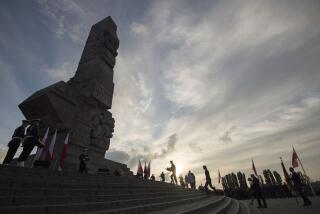Czechoslovakia’s Jewish Cemeteries--Hundreds of Them--Draw Plenty of Tourists
- Share via
PRAGUE, Czechoslovakia — The Old Jewish Cemetery here is a major tourist attraction. So is the grave in another Jewish cemetery of the writer Franz Kafka.
They are among the 600 to 700 Jewish cemeteries that remain of the 1,200 Czechoslovakia once had. The others vanished in the Nazi Holocaust in World War II or to postwar urban expansion.
One or two graveyards--some of them of great historical value--are lost to development each year, given by consent of the country’s dwindling and aging Jewish community.
The Jewish cemeteries go the way of many other Czech historical monuments that often are left to deteriorate, unless someone rises to their defense.
The few thousand Jews left in Czechoslovakia are not able to care for all the disused cemeteries. When a graveyard is lost, a rabbi or local cantor performs a ceremony, which includes ritual interment of the grave markers.
In some cases, local Protestant churches have taken over former synagogues and tend the adjoining graveyards.
The best known cemetery, in Prague’s medieval Old Town, was acquired by the Jewish community in the 15th Century and served the Jewish ghetto almost until 1800.
Space was at a premium within the walls of the ghetto, and bodies had to be buried in layers, with old grave markers pulled up to the level of new ones.
Visitors there can see the grave of the grandfather of Robert J. Oppenheimer, the U.S. physicist who led the development of the atomic bomb.
Seven of Prague’s 10 Jewish cemeteries still exist. In northern Prague is Olsany, where Kafka was buried after his death in 1924. It is the only one used now for burials. But ivy climbs everywhere because it is too difficult for the city’s Jewish community, now fewer than 1,000, to keep it trimmed.
In contrast, the historic Zizkov cemetery nearby is well-kept. It was established to bury victims of a plague in 1680 and later used for outstanding rabbis and Jews whose ancestors rendered service to Bohemian monarchs and were raised to the rank of nobility.
Zizkov’s gates are locked now, and Prague’s new television tower looms just outside the walls. The Baroque gravestones are visible through the barred gate.
On the Polish border in what used to be a thriving Silesian town with a large Jewish community, the abandoned Osoblaha (Hotzenplotz) cemetery is overgrown with brambles.
The earliest, still legible grave markers there date back to the 17th Century, but the graveyard itself is at least 200 years older, with some claiming that it dates back to the 12th Century.
A Prague expert on Jewish monuments, Jiri Fiedler, said the markers have historical value because they show the influence of Poland and differ from those in the rest of Czechoslovakia.
The local Jewish community built its first prayer house there in 1334, and its first synagogue in 1570.
In 1945, retreating German armies tried to turn the town of Osoblaha into an “invincible fortress” but left it in ruins. Now, only three ghetto houses and the cemetery are still there.
Another unique burial place is the Chatam Sofer Mausoleum with 23 graves and 64 gravestones in the Slovak capital of Bratislava. It is part of a 1680-1847 cemetery that can be reached now only through a shaft leading underground. A trolley-car line passes overhead.
Czechoslovakia’s Jewish burial grounds are the resting places for relatives of many of the world’s famous.
The parents of composer Gustav Mahler are buried in Jihlava and the ancestors of the German Marxist Rosa Luxemburg are in Jicin.
More to Read
Sign up for Essential California
The most important California stories and recommendations in your inbox every morning.
You may occasionally receive promotional content from the Los Angeles Times.










